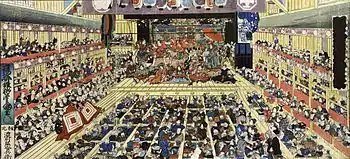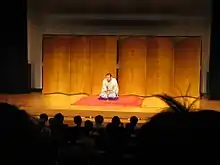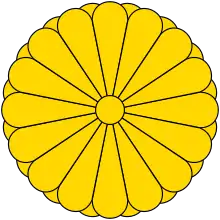Theatre of Japan
Traditional Japanese theatre includes Nō and its comic accompaniment Kyōgen, Kabuki, the puppet theatre Bunraku and the spoken theatre Yose.

Traditional forms of theatre
Nō and Kyōgen
Nō and Kyōgen theatre traditions are among the oldest continuous theatre traditions in the world. The earliest existing Kyōgen scripts date from the 15th century. Nō was a spiritual drama, combining symbolism from Buddhism and Shintoism and focusing on tales with mythic significance. Kyōgen, its comic partner, served as a link between the theological themes of the Nō play with the pedestrian world by use of theatrical farce and slapstick. Nō theatre was generally performed for the elite aristocratic class, but there were occasions where Nō was also performed for common audiences. Nō and Kyōgen plays were performed together in series of nine, alternating between the two styles, with short Kyōgen plays acting as interludes between the lengthy Nō.
Both men and women were allowed to perform Kyōgen until 1430.
Kabuki

Kabuki combines music, drama, and dance. It uses wild costumes and intense choreography. Until the 1680s, real swords were used in sword fights.
Kabuki grew out of opposition to the staid traditions of Noh theatre— dramatists wanted to shock the audience with more lively and timely stories. Tradition has it that Kabuki was first performed by Okuni in 1603. Like Nō, however, Kabuki also became a stylized, regimented art form and is still performed in the same fashion.
Bunraku
.jpg.webp)
Bunraku began in the 16th century. Puppets and bunraku were used in Japanese theatre as early as the Nō plays. medieval records prove the use of puppets in noh plays too. The puppets were 3- to 4-foot-tall (0.91 to 1.52 m) and the dolls were manipulated by puppeteers in full view of the audience. The puppeteers controlling the legs and hands of the puppets are dressed entirely in black, while the head puppeteer in contrast wears a colourful costume. Music and chanting is a popular convention of Bunraku, and the shamisen player is usually considered to be the leader of the production. The shamisen player also has the shortest hair.
Yose

Yose was a popular form of spoken theatre in the Edo period. The term is the shortened form of Hito yose seki (人寄せ席), roughly "Where people sit together". Towards the end of the Edo period, there were several hundred theatres, about one per district (町, chō). The entrance fee, the "wooden door penny" (木戸銭, Kido-zeni) was small.
A number of variants existed:
- "narrative stories" (講談, Kōdan)
- "Erotic stories" (人情噺, Ninjō-banashi)
- "comic stories" (落語, Rakugo)
- "Magic Arts" (手品, Tejina)
- "Shadow theatre" (写し絵, Utsushi-e)
- "Imitation of several people" (八人芸, Hachinin-gei)
- "Ghost Stories" (怪談, Kaidan)
- "Artful Tales" (芸屋噺)
and others.
Modern theatre
Japanese modern drama in the early 20th century, the 1900s, consisted of shingeki (experimental Western-style theatre), which employed naturalistic acting and contemporary themes in contrast to the stylized conventions of Kabuki and Nō. Hōgetsu Shimamura and Kaoru Osanai were two figures influential in the development of shingeki.
In the post-war period, there was a phenomenal growth in creative new dramatic works, which introduced fresh aesthetic concepts that revolutionized the orthodox modern theatre. Challenging the realistic, psychological drama focused on "tragic historical progress" of the Western-derived shingeki, young playwrights broke with such accepted tenets as conventional stage space, placing their action in tents, streets, and open areas located all over Tokyo.
Plots became increasingly complex, with play-within-a-play sequences, moving rapidly back and forth in time, and intermingling reality with fantasy. Dramatic structure was fragmented, with the focus on the performer, who often used a variety of masks to reflect different personae.
Playwrights returned to common stage devices perfected in noh and kabuki to project their ideas, such as employing a narrator, who could also use English for international audiences. Major playwrights in the 1980s were Kara Juro, Shimizu Kunio, and Betsuyaku Minoru, all closely connected to specific companies. In contrast, the fiercely independent Murai Shimako who won awards throughout the world for her numerous works focusing on the Hiroshima bombing, performed plays with only one or two actresses. In the 1980s, Japanese stagecraft evolved into a more refined into a more sophisticated and complex format than earlier postwar experiments but lacked their bold critical spirit. In this time period, women began to run their own theater companies such as Kishida Rio, Kisaragi Koharu, Nagai Ai, and Watanabe Eriko.[1][2]
Tadashi Suzuki developed a unique method of performer training which integrated avant-garde concepts with classical noh and kabuki techniques, an approach that became a major creative force in Japanese and international theatre in the 1980s. Another highly original east–west fusion occurred in the inspired production Nastasya, adapted from Dostoevsky's The Idiot, in which Bando Tamasaburo, a famed Kabuki onnagata (female impersonator), played the roles of both the prince and his fiancée.
Shinpa
Shinpa is a modern form of theatre. It earned the name "shinpa" (literally meaning "new school") to contrast it from "kyūha" ("old school" or kabuki) due its more contemporary and realistic stories.[3] With the success of the Seibidan troupe, however, shinpa theater ended up with a form that was closer to kabuki than to the later shingeki because of its continued use of onnagata and off-stage music.[3] As a theatrical form, it was most successful in the early 1900s as the works of novelists such as Kyōka Izumi, Kōyō Ozaki, and Roka Tokutomi were adapted for the stage.[3] With the introduction of cinema in Japan, shinpa became one of the first film genres in opposition again to kyūha films, as many films were based on shinpa plays.[4]
Shōgekijō
The 1980s also encouraged the creation of the Shōgekijō, literally little theatre. This usually meant amateur theatrical troupes making plays designed to be seen by anyone and everyone — not necessarily as meaningful in nature as they were simply entertaining. Some of the more philosophical playwrights and directors of that time are Noda Hideki and Shōji Kōkami.
Popular Shōgekijō theatrical troupes include Nylon 100, Gekidan Shinkansen, Tokyo Sunshine Boys, and Halaholo Shangrila.
Recently, new generation of Shōgekijō artists who are labelled as the "Generation of the Lost Decade" or the "Generation of 2000s" have emerged. Principal artists among this generation are: Toshiki Okada, Shiro Maeda, Kuro Tanino, Daisuke Miura, Tomohiro Maekawa and so on.[5][6]
Western plays in Japan
Many classics of the western canon from Ancient Greek theatre, William Shakespeare, Fyodor Dostoevsky to Samuel Beckett are performed in Tokyo today. A large number of performances, perhaps as many as 3,000, are given each year, making Tokyo one of the world's leading theatrical centers.
The opening of the replica of the Globe Theatre was celebrated by importing an entire British company to perform all of Shakespeare's historical plays, while other Tokyo theatres produced other Shakespearean plays including various new interpretations of Hamlet and King Lear. The Globe Theatre, located in Shin-Ōkubo in Tokyo, now belongs mostly to Johnny's Entertainment and the promotion of pop idols in the acting field.
Yukio Ninagawa is an internationally known Japanese director and playwright who often turns to elements of Shakespeare for inspiration. In 1995 he performed the "Shakespeare Tenpo 12Nen", an interpretation of the wildly popular British theatre Shakespeare Condensed: all of Shakespeare's plays in two hours. Famous actors such as Natsuki Mari and Karawa Toshiaki were involved.
See also
- Culture of Japan
- Takarazuka Revue
- GEAR, the first unlimited-run show in Japan with original contents.
- Bugaku
References
- Anan, Nobuko (2016). Contemporary Japanese Women's Theatre and Visual Arts. London: Palgrave Macmillan UK. doi:10.1057/9781137372987. ISBN 9781349557066.
- Anan, Nobuko (2017) Theatre of Kishida Rio: Towards Re-signification of 'Home" for Women in Asia. In Women in Asian Performance: Aesthetics and Politics, edited by Arya Madhavan. New York and London: Routledge. 110-123.
- Poulton, M. Cody (2007). "Shinpa". In Gabrielle H. Cody and Evert Sprinchorn (ed.). Columbia Encyclopedia of Modern Drama. Columbia University Press. pp. 1241–124 2. ISBN 978-0-231-14032-4.
- Bernardi, Joanne (2001). Writing in Light: The Silent Scenario and the Japanese Pure Film Movement. Wayne State University Press. p. 39. ISBN 0-8143-2926-8.
- Facts about Japan: Japanese Theater
- Uchino, Tadashi (2009). Crucible bodies: Postwar Japanese performance from Brecht to the new millennium. London: Seagull Books. ISBN 9781905422722. OCLC 468966186.
 This article incorporates public domain material from the Library of Congress Country Studies website http://lcweb2.loc.gov/frd/cs/. — Japan
This article incorporates public domain material from the Library of Congress Country Studies website http://lcweb2.loc.gov/frd/cs/. — Japan
External links
- Japan Cultural Profile – national cultural portal for Japan created by Visiting Arts/Japan Foundation
